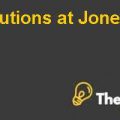
Project Friction Case Solution
As per the base case analysis, it can be said that the project is not generating high returns as (Appendix 1) shows that the project is generating very low cash flows as the project is starting to generate cash flows in the 4th year and before that the organization was incurring costs instead of generating profit. However, in the 4th year when the project began to generate cash flows, the inflows were minimum. Moreover, the project is making almost 26 million of sales and a return of nearly 3 million which is just 11% of the sales. However, these returns are quite lower since the firm cannot take any other financing if needed since the returns will not match the hurdle rate.
Apart from this, the analyst forecasted these cash flows and assumed that these cash flows will grow at 5%. The reason for choosing the growth rate 5% is that the analyst wanted to evaluate this project on moderate approach neither conservative nor liberal. Afterwards, the cash flows suggested that the project would be able to generate almost 4 million over ten years. Furthermore, the project would be able to produce sales of approximately 35 million.
However, there was an uncertainty that how much cash flows would the project produce over its total life (foreseeable life) therefore, the analyst calculated the terminal value and found that the project would make almost 27 million of real returns (returns after discounting). Finally, the analyst also calculated the NPV (Net Present Value) of the project over its ten year’s life. Findings revealed that the project will generate almost 16 million of cash flows after discounting at 10%
As far as the question that the project should be continued or not is concerned, it can be concluded that the project should be continued as the analyst had limited information, and the analysis is also made on the limited information. On the other hand, the analyst believes that the values and future cash flows may change as per approach but in this case, the investigator used moderate approach to keep the analysis simple and flexible. However, the analyst also made another calculation mentioned in the spreadsheet named as “Evaluation by Assumptions” (Appendix 2). These calculations were done to understand the project on assumptions and relative estimates, but the findings were entirely different. Therefore, the analyst suggests following the base case scenario.
Recommended Changes in the Project
There may be several changes which will be required to pursue the project successfully but among these amendments, the analyst suggests that the first action which the company should have to make is to increase the volume of rental revenues as the company is having a lot of expenses which are declining its Free Cash Flows (FCF). Afterwards, another big change which is required is the pricing strategy since the company is charging higher prices which are not allowing it to increase the rental volumes. ................
This is just a sample partial case solution. Please place the order on the website to order your own originally done case solution












